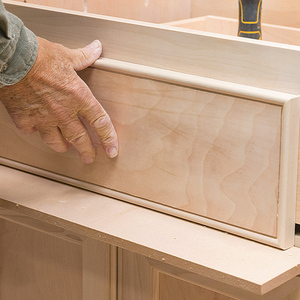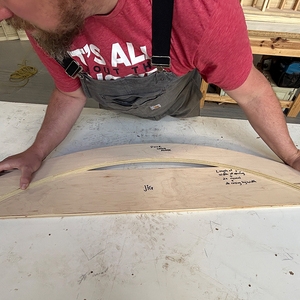*
Hi Pete
I’ve done this both ways, and you are right, gravel will not carry water away from the post that it surrounds. However, as the ground dries out, the gravel area, probably due to aeration, will dry first.
The two reasons to use post footings below grade (below frost line), with gravel packed around the post are 1) to allow easier post replacement in the future and 2) allow much easier complete removal of the post in the event you later want to do something different. Ever tried removing a 10″ by 36″ core of concrete? Whew!
Best
Bruce M



















Replies
*
Hi Pete
I've done this both ways, and you are right, gravel will not carry water away from the post that it surrounds. However, as the ground dries out, the gravel area, probably due to aeration, will dry first.
The two reasons to use post footings below grade (below frost line), with gravel packed around the post are 1) to allow easier post replacement in the future and 2) allow much easier complete removal of the post in the event you later want to do something different. Ever tried removing a 10" by 36" core of concrete? Whew!
Best
Bruce M
*
I've done it both ways and found the gravel all but useless. If I was going to go to the trouble you show I would use a post base that keeps the wood off the cement, and allows more adjustment. I can't think of the name or manufacturer, but in my area they are readily available.
*In the "old days" back in the early 80s we used to temporarily support the deck, notch the posts around the rim and let them run into the postholes,level the deck, check posts for plumb, and pour the concrete right around the posts. We used all pressure treated material for the posts and frames and they are still standing today. However the decks that we build today all sit on metal post bases. The ones that are available around here are made by TECO or SIMPSON.I'm not so sure that they will last any longer, but if you ever have to change a post it would be alot less involved.
*I do not care for the steel post bases. They are 1)costly 2)unattractive 3)subject to rust and deterioration 4)can hold water in some cases. THe method I described above is quite simple. It takes about 2-2 1/2 80# bags of quickcrete to fill a hole 42" deep by 8" wide. I simply fill the hole about 1/3 full of water and pour the dry mix right in. a few seconds later I sink the anchor bolt. Another benefit is that once the bolt is set, you can still adjust where your post is set over it by where you drill the hole in the bottom of the post. I also like to add a short piece of sonotube to the top of the hole for a nice finished look that water will not set on.Pete Draganic
*Pete you may want to consider a couple of observations about your installation.Because that we are posting to the internet, a lot of what we suggest is regional. Some readers may be in Arizona, Australia, Canada, Alaska. So what is good practice in one area could be disatrous in another.I live north of the 49th near Ottawa Canada so keep this in mind.In areas where frost is a problem, we never install a partial sono tube. In other words, auger a hole, fill it with concrete part of the way and then add a sono tube for the top section for cosmetics. Frost will lift the concrete by pushing on the irregular projections on the walls of the cast in place concrete. Here the frost, depending on the year, the soil conditions and the ground cover, can go down five feet.The use of an anchor bolt may look cleaner but may also promote moisture and rotting when you drill a hole to the underside of the post and make's it hard to monitor. I like to use brackets that are cast in the sono tube and put a foam gasket between the post and the steel.Because of the snow, I leave 1 foot of the sono tube exposed above grade and finish the top of the concrete with a modified edger.
*Pete liked your posting and drawing. Going to have to catch up with you guy's on this stuff ( as my wife say's redneck meets high teck) we have done both ways and depending on the code(remember I have to deal with three differant states, ok DC don't count as a state) we like to sit our posts on a footer 30" below grade. Then fill with concrete to 4" below final grade. We've seen a nightmare of differ ways of doing this. Most homeowners don't want the concrete to protrude above the finish grade. On some we have poured the concrete as columns to carry the deck(colored and hand rubbed to finish) Think you started a good line here
*Pete, do you worry about holddown strength? I think it's required here, I used the metal stand-off brackets and sloped the concrete to drain, plus a piece of weatherwatch on the bottom of the post. Being comfortable with the look of concrete I left the piers exposed 8" above grade, and used tube all the way down to the top of the footing to conserve concrete. There are hordes of termites and carpenter ants out there eyeing our house (some of them in it that I haven't found/evicted yet) so i emphasized rapid drainage, drying, and separation from the bare earth.(We only have to dig down 24" here (VA)! Of course, some southern wiseacre will write in that they just set the footings on the bare earth.)
*You're thinking of the APB xx (Adjustable Post Base) by Simpson. They have several version for 4x 6x in HD and regular duty. Couple of bucks and lets you adjust after the concrete is dry.
*
I have indeed built a deck or two in my day. When setting the posts, I prefer to dig the footing hole, pour concrete to the top and set an anchor bolt in the center. I then center drill my deck post and place over the bolt.
Many deck builders I have spoken with insist on burying their posts blow grade and then fill the hole partialy with gravel which they claim is for drainage. I personally think it's just cheaper/easier for them.
My question (after all this babbling) is... Does the gravel for drainage really help drain? I suspect that it would instead attract water into the hole because of it's loose packed drainage properties. The water would then stay in the hole because there are no drain tile to carry it away. Am I right in this thinking? What post setting techniques do you guys apply?
Here is a partial picture of a "generic" deck drawing that I usually submit to the local Building Departments for standard decks.
View Image height=492 border=0 alt="">
Pete Draganic